Posted: November 4th, 2014 | Author: Nathan | Filed under: music
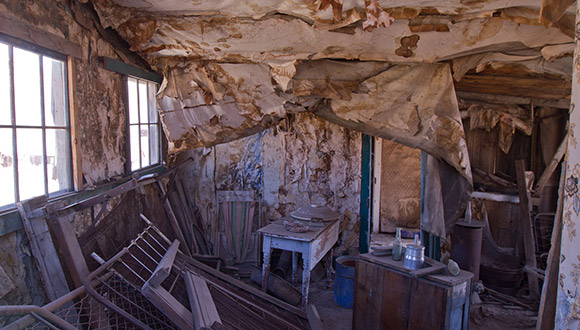
Ramshackle, loose, clattering.
This clacky, rickety ambient music track is made almost entirely from guitar sounds, primarily extended techniques, but far more melodic and structured rhythmic than work shared previously. Clearly enhanced with effects in the edit, and some percussive effects from zithers and accordions that kick in around 0:50 from Echo Collective.
It felt windswept, remote, and forlorn, so I chose this photo from the California ghost town of Bodie to accompany it. Enjoy.
[soundcloud url=”https://api.soundcloud.com/tracks/173186892″ params=”color=ff5500&auto_play=false&hide_related=false&show_comments=true&show_user=true&show_reposts=false” width=”100%” height=”166″ iframe=”true” /]
Tags: ambient, extended techniques, guitar, music 2014 | No Comments »
Posted: October 27th, 2014 | Author: Nathan | Filed under: music, synthesis

Today’s track is comprised of several ominous improvisations with analog synths: Korg Volca Beats, Korg Volca Bass, Waldorf Pulse +, and Grendel Drone Commander. A couple of virtual analog software synths were also used to round things out in the edit.
Nice to get back into the pure subtractive synthesis world for a whole, in terms of sound design. I need to grow more hands if I’m to tweak this many knobs at once…
[soundcloud url=”https://api.soundcloud.com/tracks/173187112″ params=”color=ff5500&auto_play=false&hide_related=false&show_comments=true&show_user=true&show_reposts=false” width=”100%” height=”166″ iframe=”true” /]
Tags: analogue, audio equipment, music, music 2014 | No Comments »
Posted: October 21st, 2014 | Author: Nathan | Filed under: music
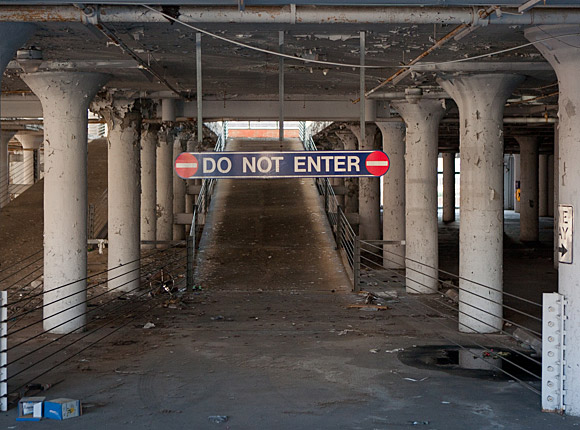
Desolate, tense, unnerving.
Imagining a largely post-human landscape with a guitar, field recordings of bowed cymbals and rusty steel objects, chromatic steel percussion, and more. Heavily influence by a winter of reading post-apocalyptic fiction novels.
Live drums by Jules König, appropriately recorded in a gritty former sweatshop.
[soundcloud url=”https://api.soundcloud.com/tracks/170806959″ params=”color=ff5500&auto_play=false&hide_related=false&show_comments=true&show_user=true&show_reposts=false” width=”100%” height=”166″ iframe=”true” /]
Tags: cinematic, composition, music, music 2014 | No Comments »
Posted: October 14th, 2014 | Author: Nathan | Filed under: music

Dusty, lonely, expansive.
As I’ve mentioned in previous posts, I have been getting back into making music this year. My creativity goes in cycles, and I’m simply cycling from sound design and field recording as its own reward into producing sounds for musical compositions. This is the first of several posts that showcase some of the tracks I’ve worked on this year.
This track was mostly an exploration of using a glass slide on a guitar, playing mostly above the bridge, an extension of the many months I’ve spent (re)learning extended playing techniques. Only three instruments were used in this track: Guitar, and Sonic Couture’s Kim and Bowed Piano instruments, and the only effect was a single Tremolo on one of the guitar tracks.
[soundcloud url=”https://api.soundcloud.com/tracks/170799603?secret_token=s-HE9n1″ params=”color=ff5500&auto_play=false&hide_related=false&show_comments=true&show_user=true&show_reposts=false” width=”100%” height=”166″ iframe=”true” /]
Tags: cinematic, music 2014 | No Comments »
Posted: October 7th, 2014 | Author: Nathan | Filed under: music
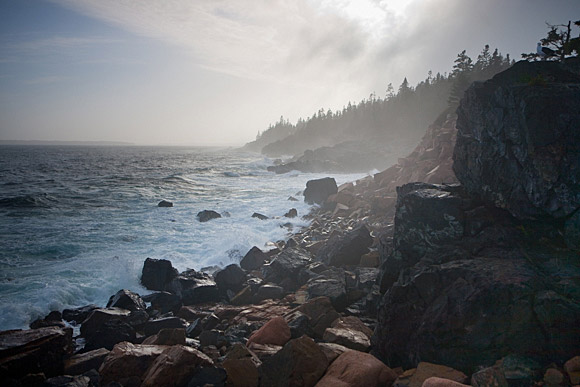
Lonely, dark, maritime.
[Author’s Note: This fall, I’ll be sharing some music I’ve worked on in 2014. A little different, but still in keeping with the concept of this blog. Hope you enjoy the change of pace for a little bit!]
I decided to try to write something in 3/4 time, which I don’t do that often. It’s so easy to make 3/4 time sound like a waltz, all poncy and upper-crust. Or, at worst, a twee indie film about awkward romance, especially with instruments that are traditionally for that time signature, like accordions. So, I tried to create a track in 3/4 that had a mix of menace and whimsy.Â
This composition features a strange arrangement of instruments: Harmonium through a distortion pedal, piano, tiny electronic percussion, timables, glockenspiel, double bass, and harp.
[soundcloud url=”https://api.soundcloud.com/tracks/170801469″ params=”color=ff5500&auto_play=false&hide_related=false&show_comments=true&show_user=true&show_reposts=false” width=”100%” height=”166″ iframe=”true” /]
Tags: cinematic, composition, music, music 2014 | No Comments »
Posted: October 1st, 2014 | Author: Nathan | Filed under: gear, music, sound design, synthesis

Hand-built for drone-y aggression.
I love handmade soundmaking devices, but outside of my beloved Grendel Drone Commander, a lot of the weird noise boxes and effects I have are, well, noisy. They tend to be aggressive, loud, and blippy. Some accept MIDI, some accept CV, some accept no sync signal at all.
One evening I wondered if I could coax them into some semblance of ambient drones, to loosen myself up and not record to a fixed tempo, and to not get too “precious” with editing in post. Somehow the angry nature of these devices just seems to bleed through anyway. Or is that my angry nature?
So, the result of this cathartic experiment was “angry ambient.” Or, angrient.
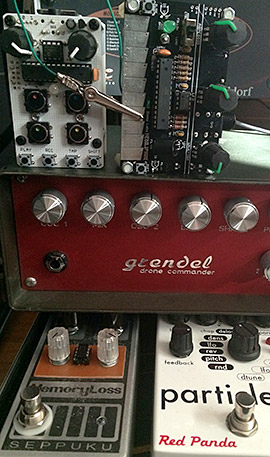
This track features the following:
- All takes recorded live into Logic Pro X: No sync to anything, no MIDI, no CV.
- One track of a Bleep Labs Nebulophone, with its alligator clip clamped onto a key for a sustained drone, recorded through a Red Panda Particle pedal set to Reverse, both tweaked live. The dry and effected track were tracked simultaneously.
- Another droned Nebulophone track went through the Particle set to Delay, and then through a Seppuku Memory Loss pedal, with its clean microchip inserted, all three tweaked live. The dry and effected track were tracked simultaneously.
- One track of the RareWaves Grendel Drone Commander, recorded 100% dry. That thing needs no love, especially when its bandpass filters gets overdriven at low frequencies. Yummy.
- One track of the Bleep Labs Bleep Drum, played live in Noise mode, but then run through Glitchmachines’ Fracture plugin first, and the Michael Norris Spectral Partial Glide filter. That’s what generates the bright, granulated shimmers. These are the only digital effects plugins on any channel.
- Volume automation was done in one pass, “live.”
- The whole thing is run through U-He’s Satin tape emulator plugin for some additional harmonics and mid-high sweetening.
It is what it is.
[soundcloud url=”https://api.soundcloud.com/tracks/168600426″ params=”color=ff5500&auto_play=false&hide_related=false&show_comments=true&show_user=true&show_reposts=false” width=”100%” height=”166″ iframe=”true” /]
Tags: audio equipment, drone, experimental, music 2014, sound design | No Comments »
Posted: September 25th, 2014 | Author: Nathan | Filed under: music, sound design

Les Paul clone, eBow, and chopsticks on a foggy Saturday morning.
This spring I rediscovered the guitar, first as a compositional tool – my music’s texture is so different when I start with the guitar and not keyboards – and soon thereafter as a tool for sound design. I started getting back into prepared guitar and extended playing techniques, and rekindled my love for vibrating steel.
In fact, the more I did it, the fewer processors and effects I used. It was weird enough already. And I like weird. It led me on a whole summer-long journey into music, as opposed to field recording or sound design, often on the cinematic tip. This fall I may share some more results of this summer’s studio musicfest.
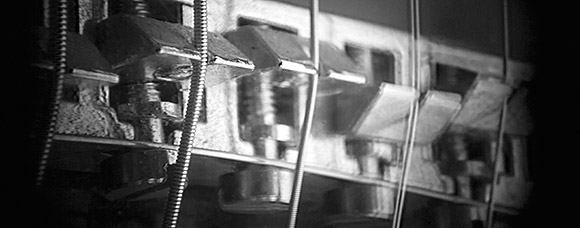
Steel is real.
Today’s sound is more drone than music, though. It’s from a live improvisation session featuring my old Epiphone Les Paul clone, an eBow, and two chopsticks stuck in the strings at the 12th fret.I also took some small alligator clips, clipped them to some strings, and flicked them against nearby strings for some filigree panned to the left and right.
No effects were used (distortion is just from the preamp) except some cutting with a low shelf EQ and a slight, broad EQ lift around 2KHz; no compression, either. The whole session has been only slightly edited in post.
Headphones and a dim room recommended.
[soundcloud url=”https://api.soundcloud.com/tracks/168600067″ params=”color=ff5500&auto_play=false&hide_related=false&show_comments=true&show_user=true&show_reposts=false” width=”100%” height=”166″ iframe=”true” /]
Tags: drone, guitar, music 2014 | No Comments »
Posted: June 25th, 2014 | Author: Nathan | Filed under: gear, music, sound design
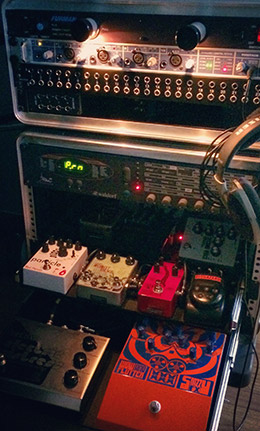
I favor discrete effects loops on rackmounted shelves, since I’m not a stomping-on-stage kind of guy.
As evidenced by a few recent posts here on Noise Jockey, I think the most exciting way to use guitar-oriented effects pedals is thinking of them as modular synthesizer units. (Indeed, it’s no accident that many boutique pedal makers are now issuing Eurorack versions of their stompboxes.) My workflow usually involves recording signals dry, then running them through the effects as sends. This gives me maximum control when composing, designing, and mixing. I keep my pedals in two distinct loops: One for sculpting and distorting tone, and one for filtering and modulation.
However, just sending signals out to pedals as effect sends from an audio interface doesn’t always work very well. Most effect pedals expect guitars at their front door, not synths, virtual instruments, samples, or field recordings. Most guitars with passive pickups, of course, are high-impedance instrument-level signals, not low-impedance line-level signals that one would expect from hardware synths, virtual instruments, or pre-recorded tracks that are coming back out via an audio interface. This can mean that the effect return might be extremely low, distorted, or noisy/hissy, depending on the signal and what specific pedals are in the effects chain.
So, there are basically two ways to address this problem.
- Use pedals that natively support line-level signals. This usually leads one to higher-end pedals like the Moogerfoogers, and they can be expensive. Rackmount multi-effect units often handle line inputs just fine, but many of those units are also expensive and, in my experience, lack the character and flexibility of a more modular approach of individual pedals. My bigger issue with this approach is that it seems silly to limit one’s creativity based on the vagaries of electrical engineering.
- Use a device in the effects chain to properly match impedances of the sent signal to the effects in the chain. This approach gives the designer, artist, musician, or engineer the best balance of creative freedom while correct managing signal level to optimize frequency response, gain, and noise levels.
DI (direct injection) boxes won’t solve this problem, since they usually output at microphone level – still a high impedance signal. No, dear friends, what you really want is a re-amping device, a box that takes any pre-recorded signal and sends it to a guitar amp or effects chain as a high impedance signal. These are as expensive as decent effect pedals themselves, but worth their weight in gold to treat your audio right and send any signal to any effect. A most egalitarian piece of electronic equipment. Many reamp devices exist, even as 500 series modules!
But remember my two-loop effects chain? Ostensibly I’d need a re-amp on each chain; that sounded expensive. Or so I thought, until I discovered the Pigtronix Keymaster.
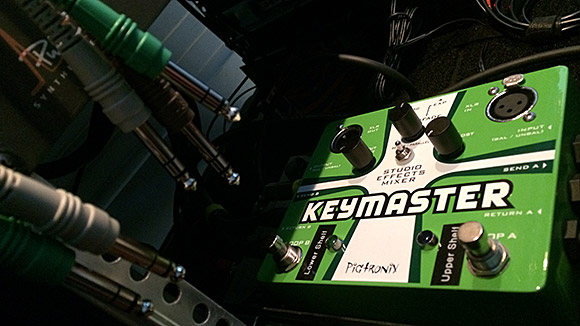
There is no impedance, only Zuul.
Besides the obvious bonus of being named after a Ghostbusters reference, the Keymaster has two dedicated re-amping loops, each with a send and return and individual loop output gain knobs. PERFECT. Heck, it even sports XLR I/O for the fancy lads and lasses. As an added weird bonus, it actually has a crossfader between each loop, should one want to switch between the two in real time. While I have used this myself musically, most of the time this large green and white box stays in the back of my effects back near my  power supply, silently channeling and impedance-matching my dry signals into mangled layers of noisy glory.
Many other re-amping boxes exist, and single-channel units are cheaper, but for maximum creative weirdness and flexibility, the Keymaster has become the core of my externalized sound design and musical effects chain, even when it’s simply a silent partner in making noisy things happen. Heck, it even  lets me run them in serial or parallel, and freed up some I/O plugs on my patchbay and audio interface.
So, if you’re interested in experimenting with effects pedals and stomp boxes as external effects devices, grab a re-amping box and hit eBay or your local guitar shop in search of fun stompboxy goodness. We’re in a golden era of boutique audio hardware creation, so there’s no better time to experiment with literally out-of-the-box noisemaking.
Today’s sound is an extremely simple drum loop, but using a bunch of effect pedals, all managed through the Keymaster. First you’ll hear a rhythmic start with just a Dwarfcraft Robot Devil pedal, with only its starved circuit creating the rhythm, being run through a Red Panda Particle pedal set on delay. Then you’ll hear a hi-hat run through a Snazzy FX Wow and Flutter pedal. A dry kick drum then starts, and the snare eventually gets the Red Panda Particle treatment as a super-wet granular delay.
[soundcloud url=”https://api.soundcloud.com/tracks/152340481″ params=”color=ff5500&auto_play=false&hide_related=false&show_artwork=false&show_comments=true&show_user=true&show_reposts=false” width=”100%” height=”166″ iframe=”true” /]
| 12 Comments »
Posted: May 6th, 2014 | Author: Nathan | Filed under: gear, music, sound design, synthesis
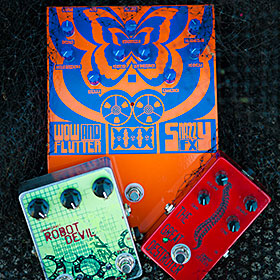
Sometimes sound design requires thinking inside of multiple boxes.
I’ve developed a small collection of handmade and boutique electronic effects and instruments over the years, like the Grendel Drone Commander, Lite2 Sound PX, and many more (perhaps the subject of another post). Longtime readers may recall that I just love supporting independent makers and small cottage industries: That’s where all the weird, truly innovative stuff happens, and I (like many of you, dear readers) am more interested in cool sound design possibilities than straight-up distorted guitarrrrrrrr sounds.
Beyond this, I’ve also been expanding my collection of effects pedals. My latest three are definitely the weirdest: The Great Destroyer and Robot Devil from Dwarfcraft Devices, and the Wow & Flutter from Snazzy FX.
Read the rest of this entry »
Tags: effect pedal, sci-fi, sound design, sound effects | No Comments »
Posted: March 25th, 2014 | Author: Nathan | Filed under: music, video/motion
We all get caught between having creative ideas, yet having extremely limited available time to explore them. To explore some personal creative ideas during an extremely busy time, I decided to give myself a challenge: Create a shortform video in 36 hours, inclusive of shooting, post, and sound.
It wouldn’t be the best thing ever, but it’d be a Thing. A Thing would be done…or as done as I could make it. The goal wasn’t to create the best thing ever…it was to make something. Period. And the time constraint would force concision, hard choices, and provide the constraints needed to be creative.
This resulted in The Barn. If you’d like to watch this short video, I’d prefer you watch this full screen. I’ll wait right here.
Given the focus of this blog, I suppose that I should speak to the music in a little more detail. I conceived, shot, and did a rough edit of the video in about a day. I slept on it, and composed the music the following morning in one session. The soundtrack is influenced by what I’ve been listening to recently: Ben Frost, Kammarheit, Erik Skodvin, Elegi, Stefan Németh, Paul Corley, and others. The music started with a sampler patch I created based on me playing my guitar with a cello bow, and some guitar plucks prepared with small magnets. Samples included wood floor creaks and static bursts that I had recorded or generated over the past year. It was created in Logic Pro 9. (The description on Vimeo addresses more about visuals for those that are interested.)
Could the music be better? More dynamic? More varied? Sure, yes, on all fronts, with no doubt. But this was an exercise in reaching done, a battle against hoping to maybe-sorta start something, and actually making something, warts and all. As they say, “Better can be the enemy of done.”
There are a bajillion things I’d like to change, improve, and alter. But in 36 hours – including decent sleep – that’s not important. The goal was to express an idea with time as the primary constraint. And the goal isn’t to continue to obsess and tweak this project: It’s done. Now it’s time for the next Thing.
I learned a lot from this small project, and will definitely do more 36-hour projects in the future. I relish constraints, even if they are arbitrary: They focus the mind like nothing else, and soothe the Blank Canvas Problem.
I welcome any thoughts, especially on the value of constraints, in the comments below. Thanks for watching and listening. I’ll return to more typical posts on field design and sound recording in the coming weeks.
Tags: composition, creativity, creepy, music 2014, video | 5 Comments »











